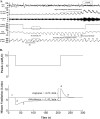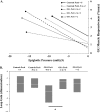Defining phenotypic causes of obstructive sleep apnea. Identification of novel therapeutic targets
- PMID: 23721582
- PMCID: PMC3826282
- DOI: 10.1164/rccm.201303-0448OC
Defining phenotypic causes of obstructive sleep apnea. Identification of novel therapeutic targets
Abstract
Rationale: The pathophysiologic causes of obstructive sleep apnea (OSA) likely vary among patients but have not been well characterized.
Objectives: To define carefully the proportion of key anatomic and nonanatomic contributions in a relatively large cohort of patients with OSA and control subjects to identify pathophysiologic targets for future novel therapies for OSA.
Methods: Seventy-five men and women with and without OSA aged 20-65 years were studied on three separate nights. Initially, the apnea-hypopnea index was determined by polysomnography followed by determination of anatomic (passive critical closing pressure of the upper airway [Pcrit]) and nonanatomic (genioglossus muscle responsiveness, arousal threshold, and respiratory control stability; loop gain) contributions to OSA.
Measurements and main results: Pathophysiologic traits varied substantially among participants. A total of 36% of patients with OSA had minimal genioglossus muscle responsiveness during sleep, 37% had a low arousal threshold, and 36% had high loop gain. A total of 28% had multiple nonanatomic features. Although overall the upper airway was more collapsible in patients with OSA (Pcrit, 0.3 [-1.5 to 1.9] vs. -6.2 [-12.4 to -3.6] cm H2O; P <0.01), 19% had a relatively noncollapsible upper airway similar to many of the control subjects (Pcrit, -2 to -5 cm H2O). In these patients, loop gain was almost twice as high as patients with a Pcrit greater than -2 cm H2O (-5.9 [-8.8 to -4.5] vs. -3.2 [-4.8 to -2.4] dimensionless; P = 0.01). A three-point scale for weighting the relative contribution of the traits is proposed. It suggests that nonanatomic features play an important role in 56% of patients with OSA.
Conclusions: This study confirms that OSA is a heterogeneous disorder. Although Pcrit-anatomy is an important determinant, abnormalities in nonanatomic traits are also present in most patients with OSA.
Figures




Comment in
-
Emergence of obstructive sleep apnea phenotyping. From weak to strong!Am J Respir Crit Care Med. 2013 Oct 15;188(8):898-900. doi: 10.1164/rccm.201309-1587ED. Am J Respir Crit Care Med. 2013. PMID: 24127798 No abstract available.
-
Arousal threshold in obstructive sleep apnea.Am J Respir Crit Care Med. 2014 Feb 1;189(3):372-3. doi: 10.1164/rccm.201311-1988LE. Am J Respir Crit Care Med. 2014. PMID: 24484349 Free PMC article. No abstract available.
-
Reply: Arousal threshold in obstructive sleep apnea.Am J Respir Crit Care Med. 2014 Feb 1;189(3):373-4. doi: 10.1164/rccm.201312-2115LE. Am J Respir Crit Care Med. 2014. PMID: 24484350 Free PMC article. No abstract available.
References
-
- Young T, Palta M, Dempsey J, Skatrud J, Weber S, Badr S. The occurrence of sleep-disordered breathing among middle-aged adults. N Engl J Med. 1993;328:1230–1235. - PubMed
-
- Yaggi HK, Concato J, Kernan WN, Lichtman JH, Brass LM, Mohsenin V. Obstructive sleep apnea as a risk factor for stroke and death. N Engl J Med. 2005;353:2034–2041. - PubMed
-
- Kribbs NB, Pack AI, Kline LR, Smith PL, Schwartz AR, Schubert NM, Redline S, Henry JN, Getsy JE, Dinges DF. Objective measurement of patterns of nasal CPAP use by patients with obstructive sleep apnea. Am Rev Respir Dis. 1993;147:887–895. - PubMed
-
- White DP. Pathogenesis of obstructive and central sleep apnea. Am J Respir Crit Care Med. 2005;172:1363–1370. - PubMed
Publication types
MeSH terms
Grants and funding
- R01HL110350/HL/NHLBI NIH HHS/United States
- R01 102231/PHS HHS/United States
- K24 HL 093218/HL/NHLBI NIH HHS/United States
- R01 HL090897/HL/NHLBI NIH HHS/United States
- R01 HL085188/HL/NHLBI NIH HHS/United States
- 5R01HL048531/HL/NHLBI NIH HHS/United States
- P01 HL095491/HL/NHLBI NIH HHS/United States
- UL1 RR 025758-01/RR/NCRR NIH HHS/United States
- R01 HL102321/HL/NHLBI NIH HHS/United States
- P01 HL 095491/HL/NHLBI NIH HHS/United States
- UL1 RR025758/RR/NCRR NIH HHS/United States
- K24 HL093218/HL/NHLBI NIH HHS/United States
- R01 HL110350/HL/NHLBI NIH HHS/United States
- R01 HL048531/HL/NHLBI NIH HHS/United States
LinkOut - more resources
Full Text Sources
Other Literature Sources
Medical

